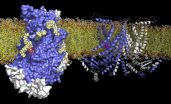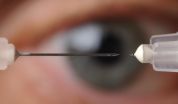Architecture of a lipid transport protein revealed
2014-11-13
(Press-News.org) Membranes are thin walls that surround cells and protect their interior from the environment. These walls are composed of phospholipids, which, due to their amphiphilic nature, form bilayers with dis-tinct chemical properties: While the outward-facing headgroups are charged, the core of the bilayer is hydrophobic, which prevents charged molecules from passing through. The controlled flow of ions across the membrane, which is essential for the transmission of nerve impulses, is facilitated by ion channels, membrane proteins that provide gated pathways for ions. Analogous to ion channels, lipid scramblases facilitate the passage of phospholipids beween the two layers of a membrane, a process that plays a key role in the intitiation of blood coagulation. Until recently, however, the architecture of these lipid scramblases remained unknown
Now, for the first time, researchers from the Department of Biochemistry of the University of Zurich, have succeeded in the structure determination of a lipid scramblase. A team of scientists in the group of Professor Raimund Dutzler unveiled the structure of a lipid scramblase from the TMEM16 family by X-ray crystallography. The structure provides insight into the activation of the protein by calcium and the transport of lipids. The work has now been published in the scientific journal Nature.
The architecture of a new membrane protein family
Membrane proteins of the TMEM16 family show a unique functional breadth, since they include, be-sides ion channels, which are essential for regulating of smooth muscle contraction, olfaction and eptithelial chloride secretion, also proteins that act as lipid scramblases. When activated by calcium, these lipid scramblases located in the plasma membrane of blood platelets trigger blood coagulation by facilitating the transport of the lipid phosphatidylserine to the surface of the cell. In order to under-stand this process, the researchers have characterized the structure and function of a closely related fungal TMEM16 lipid scramblase. Their work has revealed a novel protein architecture that is com-mon to the entire family and offers insight into lipid transport.
"The protein contains a charged crevice, which traverses the membrane in the form of a spiral stair-case. This allows the polar headgroup of lipids to move from one side of the membrane to the other," explains first author Janine Brunner. In the vicinity of this crevice, there are bound calcium ions sur-rounded by conserved, negatively charged side chains. Mutations in the calcium binding site impair lipid transport. By studying the calcium dependence of channel activation in the related TMEM16 chloride channels by electrophysiology, the scientists demonstrated the conservation of this calcium binding mode within the TMEM16 family.
Basis for new therapies
The results form the basis for understanding previously unknown mechanisms of lipid transport. "We have now gained insight into the architecture and function of a family of proteins, the malfunctioning of which causes various hereditary diseases," says the biochemist from UZH. The modulation of the-se proteins by specific drugs could be a potential strategy for novel therapies - such as the treatment of Scotts syndrome, a blood coagulation disorder, or of a muscle disease associated with the mal-functioning of TMEM16 proteins.
INFORMATION:
The project was funded by the European Research Council and the Swiss National Science Founda-tion's National Center of Competence in Research "TransCure".
Literature:
Janine D. Brunner, Novandy. K. Lim, Stephan Schenck, Alessia Duerst and Raimund Dutzler. X-ray structure of a calcium-activated TMEM16 lipid scramblase. Nature. November 12, 2014. doi: 10.1038/nature13984
[Attachments] See images for this press release:

ELSE PRESS RELEASES FROM THIS DATE:
2014-11-13
A cat always lands on its feet. At least, that's how the adage goes. Karen Liu hopes that in the future, this will be true of robots as well.
To understand the way feline or human behavior during falls might be applied to robot landings, Liu, an associate professor in the School of Interactive Computing (IC) at Georgia Tech, delved into the physics of everything from falling cats to the mid-air orientation of divers and astronauts.
In research presented at the 2014 IEE/RSJ International Conference on Intelligent Robots and Systems (IROS), Liu shared her studies of mid-air ...
2014-11-13
Weather, which changes day-to-day due to constant fluctuations in the atmosphere, and climate, which varies over decades, are familiar. More recently, a third regime, called "macroweather," has been used to describe the relatively stable regime between weather and climate.
A new study by researchers at McGill University and UCL finds that this same three-part pattern applies to atmospheric conditions on Mars. The results, published in Geophysical Research Letters, also show that the sun plays a major role in determining macroweather.
The research promises to advance ...
2014-11-13
Duchenne muscular dystrophy is the most common neuromuscular disease of children (affecting 1 boy in 3500-5000 births). It is caused by a genetic defect in the DMD gene residing on the X chromosome, which results in the absence of the dystrophin protein essential to the proper functioning of muscles.
The treatment being developed by researchers at Atlantic Gene Therapies, Généthon and the Institute of Myology, is based on the use of an AAV vector (Adeno Associated Virus) carrying a transgene for the skipping of a specific exon which allows functional dystrophin ...
2014-11-13
After graphene was first produced in the lab in 2004, thousands of laboratories began developing graphene products worldwide. Researchers were amazed by its lightweight and ultra-strong properties. Ten years later, scientists now search for other materials that have the same level of potential.
"We continue to work with graphene, and there are some applications where it works very well," said Mark Hersam, the Bette and Neison Harris Chair in Teaching Excellence at Northwestern University's McCormick School of Engineering and Applied Science, who is a graphene expert. ...
2014-11-13
High blood pressure - already a massive hidden killer in Nigeria - is set to sharply rise as the country adopts western lifestyles, a study suggests.
Researchers who conducted the first up-to-date nationwide estimate of the condition in Nigeria warn that this will strain the country's already-stretched health system.
Increased public awareness, lifestyle changes, screening and early detection are vital to tackle the increasing threat of the disease, they say.
High blood pressure - also known as hypertension - is twice as high in Nigeria compared with other East ...
2014-11-13
Researchers at The University of Texas have found that compared to Caucasian Americans, African Americans have impaired blood flow regulation in the brain that could contribute to a greater risk of cerebrovascular diseases such as stroke, transient ischaemic attack ("mini stroke"), subarachnoid haemorrhage or vascular dementia. These findings were published in Experimental Physiology, the journal of The Physiological Society.
Cerebrovascular diseases can result from reduced blood flow in affected areas of the brain. It is still unclear why African Americans are at higher ...
2014-11-13
Needles almost too small to be seen with the unaided eye could be the basis for new treatment options for two of the world's leading eye diseases: glaucoma and corneal neovascularization.
The microneedles, ranging in length from 400 to 700 microns, could provide a new way to deliver drugs to specific areas within the eye relevant to these diseases. By targeting the drugs only to specific parts of the eye instead of the entire eye, researchers hope to increase effectiveness, limit side effects, and reduce the amount of drug needed.
For glaucoma, which affects about 2.2 ...
2014-11-13
(PHILADELPHIA) - Glioblastoma is the most common aggressive primary brain tumor, and despite advances in standard treatment, the median survival is about 15 months (compared to 4 months without treatment). Researchers at Thomas Jefferson University have been working on a cancer vaccine that would extend that survival by activating the patient's immune system to fight the brain tumor. A study published online November 13th in the journal Cancer Immunology, Immunotherapy drilled down to the cellular and molecular mechanisms behind the vaccine, paving the way for further development ...
2014-11-13
Hospitalized premature infants are exposed to unsafe levels of a chemical found in numerous medical products used to treat them, raising questions about whether critically ill newborns may be adversely affected by equipment designed to help save their lives.
The chemical, di(2-ethylhexyl)phthalate (DEHP), is used to increase flexibility of many plastic devices. These products, made from polyvinyl chloride (PVC), include most intravenous tubing, catheters, endotracheal tubes, and fluid and blood product bags. DEHP doesn't bind chemically to PVC, and is able to leach into ...
2014-11-13
In a new study, Use of Social Network Sites at Work: Does it Impair Performance?, Postdoctoral Fellow Cecilie Schou Andreassen and colleagues at the University of Bergen's (UiB) Department of Psychosocial Science looked at the consequences of the use of social media during working hours.
Every day, more than one billion people worldwide use social media. This habit has also invaded the workplace, as some research reports that four out of five employees use social media for private purpose during working hours.
Surprisingly, although this type of distraction may potentially ...
LAST 30 PRESS RELEASES:
[Press-News.org] Architecture of a lipid transport protein revealed


